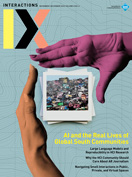Authors:
Thomas Kosch, Sebastian Feger
Large language models (LLMs) affect and transform most areas of daily life, from education and gaming to creativity and work. Exemplary LLMs are Llama, Alpaca, and GPT-4, with the latter being made accessible to the general public through OpenAI's ChatGPT. Consequently, ChatGPT reached 1 million users within five days after its release and currently has more than 180 million users (https://explodingtopics.com/blog/chatgpt-users). In light of the fast-paced developments over the past few years and today's adoption of LLMs across large parts of society, these models have also attracted a great deal of research interest. With the rapid development in natural…
You must be a member of SIGCHI, a subscriber to ACM's Digital Library, or an interactions subscriber to read the full text of this article.
GET ACCESS
Join ACM SIGCHIIn addition to all of the professional benefits of being a SIGCHI member, members get full access to interactions online content and receive the print version of the magazine bimonthly.
Subscribe to the ACM Digital Library
Get access to all interactions content online and the entire archive of ACM publications dating back to 1954. (Please check with your institution to see if it already has a subscription.)
Subscribe to interactions
Get full access to interactions online content and receive the print version of the magazine bimonthly.






